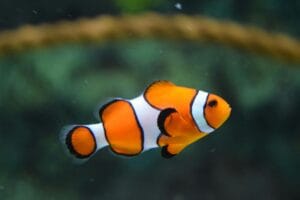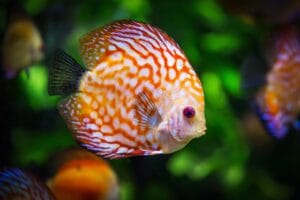Easy Aquatics: Top 10 Low-Maintenance Fish for Beginners

Aquarium enthusiasts often find themselves overwhelmed with the complexity of caring for a variety of aquatic species. For beginners, the ideal solution lies in starting with low-maintenance fish. These species offer an accessible gateway into the world of fishkeeping, allowing new aquarists to enjoy the beauty of an aquarium without the burden of constant attention. Whether you are new to fishkeeping or looking to expand your collection, understanding which fish are easy to care for can make all the difference in establishing a thriving, low-maintenance aquatic environment.
Why Low-Maintenance Fish Are Perfect for Beginners
Fishkeeping requires a balance of patience, knowledge, and dedication. For beginners, the idea of maintaining water quality, managing feeding schedules, and addressing potential diseases can seem daunting. Low-maintenance fish alleviate many of these challenges. These species are hardy, adaptable, and forgiving, requiring minimal intervention from the owner. Their resilience to fluctuations in water quality, ease of care, and compatibility with other species make them the perfect starting point for those new to the hobby.
The Benefits of Starting with Easy Aquatic Species
Starting with easy-to-care-for fish has several advantages for new aquarists. First, they help build confidence by minimizing the risks of making mistakes. The less demanding nature of these fish allows beginners to focus on learning essential fishkeeping skills, such as water testing, feeding, and tank maintenance. Additionally, low-maintenance fish tend to be more tolerant of environmental changes, reducing the need for frequent troubleshooting. These species are also often more colorful and visually appealing, making them an attractive addition to any aquarium without the added stress of constant care.
Overview of the Top 10 Low-Maintenance Fish for Beginners
There are numerous species of fish suitable for beginners, but some stand out due to their particularly low-maintenance requirements. These top 10 fish are not only easy to care for but also offer a range of colors, personalities, and benefits. Whether you seek a lively community tank or a more solitary environment, these species will provide a rewarding and straightforward fishkeeping experience.
Understanding Low-Maintenance Fish
Before diving into the specifics of individual species, it’s important to understand what makes a fish low-maintenance. These species are typically hardy, adaptable, and capable of thriving in a variety of tank conditions. They require less frequent water changes, have simple dietary needs, and are often resistant to common diseases. Additionally, many low-maintenance fish are compatible with other species, making them ideal for community tanks.
What Makes a Fish Low-Maintenance
Several key characteristics define low-maintenance fish. Their resilience to changes in water temperature, pH, and other environmental factors allows them to thrive without requiring constant monitoring. Furthermore, their feeding needs are usually straightforward, and they are less prone to illness. Low-maintenance fish are also typically less sensitive to water quality, making them less likely to suffer from common tank issues like ammonia or nitrite spikes.
Key Traits to Look for in Beginner-Friendly Fish
When selecting low-maintenance fish for a beginner aquarium, several traits should be prioritized. These include hardiness, ease of feeding, low aggression levels, and tolerance for a range of water conditions. Beginner-friendly fish should also be adaptable to community tanks, as many new aquarists start with multi-species environments. Additionally, the fish should be visually appealing and active, offering enjoyment without requiring intricate care.
How Low-Maintenance Fish Simplify Fishkeeping
Low-maintenance fish simplify fishkeeping by reducing the frequency of water changes, easing feeding schedules, and minimizing the need for constant monitoring of tank parameters. Their ability to tolerate a range of environmental factors means beginners can focus on mastering basic fishkeeping skills without becoming overwhelmed. These fish also tend to be more resilient to stress, which translates into fewer health issues and less time spent troubleshooting.
Factors to Consider When Choosing Fish
Choosing the right fish for a beginner aquarium involves several key factors. A beginner should evaluate the size of the tank, the species’ compatibility with other fish, and the specific care needs of each species. These factors ensure that the fish thrive in the tank environment and that the fishkeeper’s experience remains enjoyable.
Tank Size Requirements for Low-Maintenance Fish
The size of the tank plays a crucial role in determining which fish are suitable for beginners. While many low-maintenance fish can adapt to smaller tanks, it is essential to provide enough space for them to move freely and express natural behaviors. A well-sized tank also ensures that water quality remains stable and that the fish have ample room to thrive without overcrowding. Typically, a 10-gallon tank is an ideal starting point for most beginner species, with larger tanks providing more stability and options for tankmates.
Compatibility with Other Fish Species
Low-maintenance fish often coexist peacefully with other species, making them ideal for community tanks. However, it is important to consider the temperaments of different species before introducing them to the same environment. Some species may become territorial, while others may prefer solitude. Beginners should research species’ compatibility to avoid aggression and ensure a harmonious aquatic community.
Dietary Needs and Feeding Ease
The dietary requirements of low-maintenance fish are often simple. Many of these species are omnivores or herbivores, requiring only basic fish flakes, pellets, or live foods. A straightforward feeding schedule is also essential for new aquarists, as it ensures consistent nutrition while preventing overfeeding, which can lead to water quality issues. These fish often thrive on minimal intervention, further reducing the overall maintenance required.
Water Conditions and Tolerance Levels
Low-maintenance fish are generally more tolerant of variations in water temperature, pH, and hardness. This makes them ideal for beginner aquariums, as water quality can sometimes fluctuate, especially in the early stages of tank setup. While it is still essential to monitor water parameters regularly, these fish are more forgiving of minor mistakes, allowing the aquarist to correct issues without causing harm to the fish.
The Top 10 Low-Maintenance Fish for Beginners
Guppies: Colorful, Hardy, and Easy to Care For
Guppies are an excellent choice for beginners, known for their vibrant colors and simple care requirements. These small fish are easy to feed and adapt well to a variety of water conditions. Guppies are also highly social, thriving in community tanks. Their peaceful nature and high reproductive rate make them a fascinating addition to any aquarium.
Betta Fish: Low-Maintenance Elegance with a Unique Personality
Betta fish, also known as Siamese fighting fish, are incredibly hardy and require minimal care. These fish are ideal for solo tanks due to their territorial nature but can add a pop of color and elegance to any space. Betta fish are relatively easy to feed and maintain, making them an excellent choice for beginners looking for a low-maintenance yet visually striking species.
Neon Tetras: Small, Vibrant, and Perfect for Community Tanks
Neon tetras are small, colorful fish that add vibrancy to any aquarium. Their calm demeanor makes them ideal for community tanks, and they adapt easily to a variety of water conditions. Neon tetras are also undemanding in terms of diet and care, making them a perfect option for new aquarists.
Zebra Danios: Active Swimmers with High Resilience
Zebra danios are fast swimmers with a lively personality, perfect for beginners who enjoy an active aquarium. These fish are resilient and can tolerate a wide range of water temperatures and conditions. Their peaceful nature makes them compatible with other species, and their active behavior keeps the aquarium dynamic.
Corydoras Catfish: Bottom Dwellers That Keep the Tank Clean
Corydoras catfish are peaceful bottom-dwellers that help maintain a clean tank by scavenging leftover food. Their gentle disposition and hardiness make them ideal for beginner aquariums. They thrive in groups, so it’s best to keep them in schools of three or more. Corydoras are also forgiving of minor water quality issues, making them an easy species to care for.
Platies: Peaceful and Prolific with Minimal Demands
Platies are small, peaceful fish that come in a wide range of colors. These hardy fish are easy to care for and thrive in community tanks. Platies are also prolific breeders, providing a fascinating look into the life cycle of fish. Their simple dietary needs and tolerance for various water conditions make them an excellent choice for new aquarists.
Swordtails: Hardy Fish with Striking Looks
Swordtails are known for their long, sword-shaped tails and vibrant colors. These fish are hardy and easy to care for, thriving in community tanks. Swordtails are also relatively simple to feed and can tolerate a variety of water conditions. Their striking appearance and low-maintenance care make them a great option for beginners.
Mollies: Adaptable Fish That Thrive in Various Conditions
Mollies are adaptable fish that can live in both freshwater and brackish water. They are easy to care for and thrive in a variety of tank setups. Mollies are also peaceful and social, making them suitable for community tanks. Their hardiness and ability to adapt to different water conditions make them an excellent choice for new fishkeepers.
Cherry Shrimp: Low-Maintenance Invertebrates for Added Variety
Cherry shrimp are small, colorful invertebrates that add diversity to a beginner aquarium. They are incredibly low-maintenance, requiring minimal care while helping to keep the tank clean by eating algae and debris. These shrimp are peaceful and easy to care for, making them a great addition to a low-maintenance tank.
Snails: Functional Cleaners That Complement Low-Maintenance Fish
Snails are not only low-maintenance but also serve as efficient cleaners, eating leftover food and algae. They are hardy and adaptable, making them an excellent complement to low-maintenance fish. Snails are easy to care for and can thrive in a variety of tank environments.
Setting Up the Ideal Environment
Creating the right environment for your low-maintenance fish is essential for ensuring their well-being and longevity. From selecting the right tank size to choosing the appropriate substrate and decorations, each element of the tank setup plays a role in creating a thriving ecosystem.
Selecting the Right Tank Size for Your Fish
Choosing the correct tank size is vital for providing your fish with the space they need to thrive. A 10-gallon tank is often recommended for beginners, as it provides ample space for a small community of fish. A larger tank offers greater stability in terms of water quality and allows for a wider variety of species to coexist peacefully.
Best Substrate and Decorations for a Low-Maintenance Tank
The substrate (gravel, sand, etc.) and decorations in your aquarium should complement the needs of your fish while also being easy to clean. Choose a substrate that promotes healthy plant growth and provides hiding places for your fish. Decorations like rocks, driftwood, and plants can enhance the aesthetic of the tank while also serving as essential hiding spots for shy species.
Essential Equipment for Maintaining Water Quality
To ensure your tank remains low-maintenance, invest in reliable equipment that supports water quality. A quality filtration system is essential for maintaining clear water and removing toxins. Additionally, a heater and thermometer will help regulate the water temperature, ensuring it stays within the optimal range for your fish.
Choosing the Right Plants for Beginner Tanks
Live plants are an excellent addition to beginner aquariums. They help maintain water quality by absorbing excess nutrients and providing oxygen. Choose hardy plants like Java moss, Anubias, or Amazon sword plants, which are easy to care for and can thrive in a range of water conditions.
Feeding Low-Maintenance Fish
Feeding is a simple but crucial aspect of fishkeeping. To keep your fish healthy, offer a balanced diet tailored to their specific species. A mix of flake food, pellets, and occasional live or frozen food will meet most species’ nutritional needs. It’s important to feed your fish consistently but avoid overfeeding, as this can lead to poor water quality.
How to Select the Best Food for Each Species
Each fish species has unique dietary requirements. Research the specific food preferences of your fish and select foods that align with their nutritional needs. High-quality flake foods, pellets, and live foods are great options for most low-maintenance fish species.
The Importance of a Consistent Feeding Schedule
Establishing a consistent feeding schedule is essential for your fish’s health. Feed your fish once or twice a day, depending on the species. Avoid overfeeding, as excess food can quickly deteriorate water quality and lead to health issues for your fish.
Avoiding Overfeeding and Maintaining Clean Water
Overfeeding is one of the most common mistakes made by beginners. Excess food can break down into waste, polluting the water and harming your fish. Be sure to remove any uneaten food from the tank within a few minutes of feeding to maintain clean water.
Maintaining a Healthy Tank
Maintaining a healthy tank is key to ensuring your fish live long, happy lives. Regular water changes, monitoring water parameters, and keeping the tank clean will help prevent common issues and promote the overall health of your fish.
The Role of Water Changes in Tank Health
Regular water changes are essential for maintaining water quality and preventing the buildup of harmful toxins. Perform partial water changes of 10-20% every one to two weeks, depending on the size of your tank and the number of fish.
How to Test and Monitor Water Parameters
To maintain optimal water quality, regularly test the pH, ammonia, nitrite, and nitrate levels in your tank. A reliable water test kit will help you monitor these parameters and ensure they stay within safe ranges for your fish.
Tips for Preventing Common Issues Like Algae Growth
Algae growth can be a common issue in aquariums, but it is easy to manage. Limiting light exposure, removing excess nutrients, and maintaining a regular cleaning schedule will help prevent algae overgrowth and keep your tank looking pristine.
Troubleshooting Common Problems
While low-maintenance fish are generally resilient, issues may still arise. Knowing how to recognize signs of stress, illness, or aggression is important for addressing problems before they escalate.
Recognizing Signs of Stress in Low-Maintenance Fish
Stress can manifest in various ways, such as loss of appetite, lethargy, or abnormal swimming behavior. Regular observation of your fish will help you identify signs of stress early, allowing you to address potential issues before they become serious.
How to Handle Illness or Disease in Your Tank
If illness strikes, it’s important to act quickly. Quarantine affected fish to prevent the spread of disease, and research appropriate treatments for the condition. Regularly clean the tank and perform water changes to reduce the risk of illness in the future.
Dealing with Aggression or Incompatibility Issues
Aggression between fish can sometimes arise, especially if incompatible species are housed together. Research the temperaments of each species before introducing them to the tank and be prepared to separate fish if conflicts occur.
Tips for Long-Term Success
Creating a Low-Stress Routine for Tank Maintenance
A successful aquarium requires a consistent and stress-free maintenance routine. By adhering to regular water changes, monitoring water quality, and maintaining a clean tank, you will ensure the long-term health and happiness of your fish.
Expanding Your Aquarium Hobby with Confidence
As your confidence and experience grow, consider expanding your aquarium by adding new species or increasing the tank size. Starting with low-maintenance fish provides a strong foundation for more advanced fishkeeping adventures.
The Joy of Owning a Low-Maintenance, Vibrant Aquarium
Owning a low-maintenance aquarium is a rewarding experience that brings beauty, relaxation, and joy to any home. With the right care and attention, your low-maintenance fish will thrive, providing you with a vibrant and peaceful aquatic environment.
Conclusion
Recap of the Top 10 Low-Maintenance Fish for Beginners
The top 10 low-maintenance fish for beginners provide a great starting point for anyone new to the hobby. From guppies and bettas to snails and shrimp, these species are hardy, easy to care for, and compatible with one another.
Encouragement to Start Your Aquatic Journey Today
Embarking on your fishkeeping journey with low-maintenance fish is a rewarding and fulfilling experience. With the right knowledge and care, you can create a thriving aquarium that will bring joy for years to come.
The Rewards of Easy and Enjoyable Fishkeeping
The satisfaction of watching your fish flourish and your tank thrive is unmatched. Low-maintenance fish provide an enjoyable introduction to the hobby, allowing you to experience the joys of aquatics with minimal effort.



